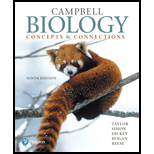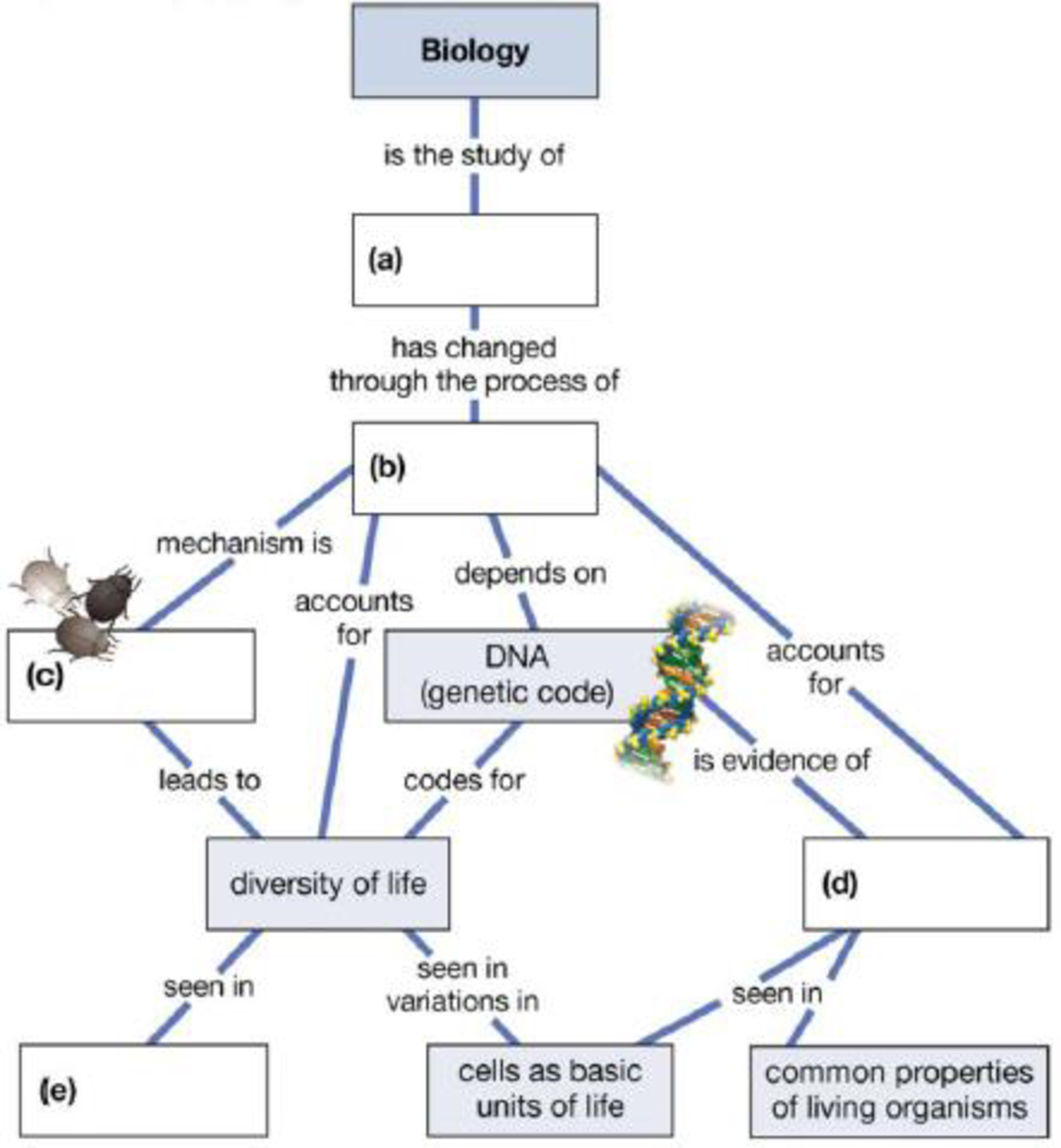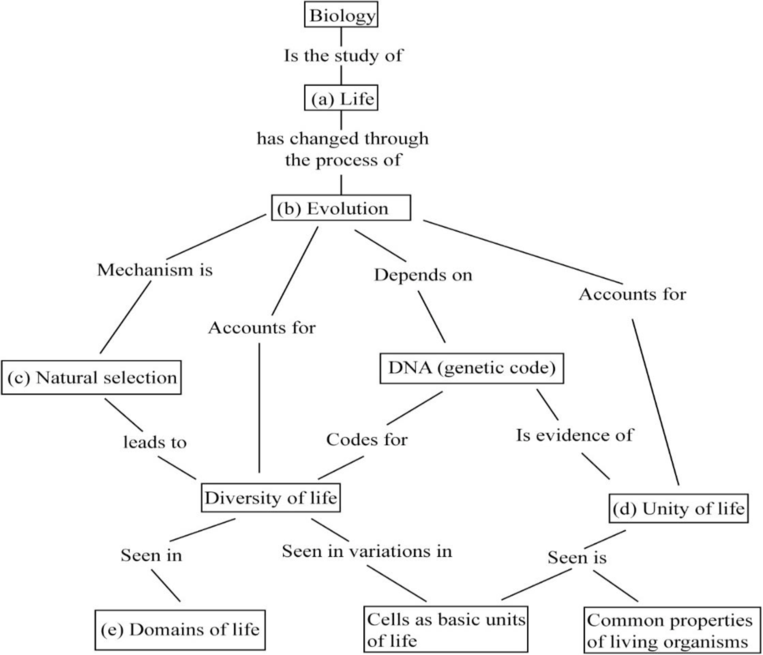
Concept explainers
Complete the following map organizing one of biology’s major themes.

To complete: The given map showing a major biological theme.
Introduction: The five major themes present in all biological systems are as follows:
Theme 1: “Evolution is the core theme of biology”.
Theme 2: “Life depends on the flow of information”.
Theme 3:“Structure and functions are related”.
Theme 4: “Life depends on the transfer and transformation of energy and matter”.
Theme 5: “Life depends on interactions within and between systems”.
Answer to Problem 1CC
Fig. 1 shows the completed map of evolution, one of the core themes in biology given in the textbook.
Pictorial representation: Fig. 1 shows the completed map of the core theme of biology: evolution.

Fig.1 Evolution as a core theme of biology
Explanation of Solution
(a)
Correct answer: Life
The term “biology” is defined as the branch of science that studies life (in Greek: bio= life; -ologia= study of). Hence, the correct answer is life.
(b)
Correct answer: Evolution
Evolution is defined as the continuous process of changes that have occurred over a long time to transform the living beings from their earliest simplest forms to the present-day wide variety of species. It can be summarized as “descent with modification”, that is, all species have evolved from common ancestors through several continuous changes over time. Thus, evolution is the process that has changed life. Hence, the correct answer is evolution.
(c)
Correct answer: Natural selection
Researcher Charles Darwin proposed the phenomenon of “natural selection” as the mechanism for evolution. In a large population of species, individuals show several variations in their traits; out of which, some variations are more favorable for survival, utilization of resources, and better reproductive success of selected individuals. This phenomenon of better adaptation, survival, and reproductive success of selected individuals due to the presence of certain traits or variations is called natural selection. These selected individuals are able to pass their traits to their next generation, and thus their population increases, slowly by transforming the population, leading to evolution. Thus, natural selection is the mechanism that drives evolution. Hence, the correct answer is natural selection.
(d)
Correct answer: Unity of life
Deoxyribonucleic acid (DNA) is present in most of the living organisms that help in the flow of information from one generation to the other and changes in which lead to evolution. Thus, it is a proof for unity among all life forms.
Evolution has led to the development of various species from a common ancestor through continuous changes. Thus, it shows unity among all life forms. Genetic code as DNA and evolution show unity of life. Hence, the correct answer is unity of life.
(e)
Correct answer: Domains of life
DNA that encodes the genetic information is present in most of the living organisms classified into various domains of life. There are a large number of organisms of various types from simple single-celled bacteria to highly complex and multicellular animals. The basis of their diversity is the genetic information coded in their genetic material, usually DNA. Differences in DNA sequences cause diversity among organisms belonging to different domains of life. Hence, the correct answer is domains of life.
Want to see more full solutions like this?
Chapter 1 Solutions
Campbell Biology: Concepts & Connections (9th Edition)
- Ch.21 What causes patients infected with the yellow fever virus to turn yellow (jaundice)? A. low blood pressure and anemia B. excess leukocytes C. alteration of skin pigments D. liver damage in final stage of disease — What is the advantage for malarial parasites to grow and replicate in red blood cells? A. able to spread quickly B. able to avoid immune detection C. low oxygen environment for growth D. cooler area of the body for growth — Which microbe does not live part of its lifecycle outside humans? A. Toxoplasma gondii B. Cytomegalovirus C. Francisella tularensis D. Plasmodium falciparum — explain your answer thoroughlyarrow_forwardCh.22 Streptococcus pneumoniae has a capsule to protect it from killing by alveolar macrophages, which kill bacteria by… A. cytokines B. antibodies C. complement D. phagocytosis — What fact about the influenza virus allows the dramatic antigenic shift that generates novel strains? A. very large size B. enveloped C. segmented genome D. over 100 genes — explain your answer thoroughlyarrow_forwardWhat is this?arrow_forward
- Molecular Biology A-C components of the question are corresponding to attached image labeled 1. D component of the question is corresponding to attached image labeled 2. For a eukaryotic mRNA, the sequences is as follows where AUGrepresents the start codon, the yellow is the Kozak sequence and (XXX) just represents any codonfor an amino acid (no stop codons here). G-cap and polyA tail are not shown A. How long is the peptide produced?B. What is the function (a sentence) of the UAA highlighted in blue?C. If the sequence highlighted in blue were changed from UAA to UAG, how would that affecttranslation? D. (1) The sequence highlighted in yellow above is moved to a new position indicated below. Howwould that affect translation? (2) How long would be the protein produced from this new mRNA? Thank youarrow_forwardMolecular Biology Question Explain why the cell doesn’t need 61 tRNAs (one for each codon). Please help. Thank youarrow_forwardMolecular Biology You discover a disease causing mutation (indicated by the arrow) that alters splicing of its mRNA. This mutation (a base substitution in the splicing sequence) eliminates a 3’ splice site resulting in the inclusion of the second intron (I2) in the final mRNA. We are going to pretend that this intron is short having only 15 nucleotides (most introns are much longer so this is just to make things simple) with the following sequence shown below in bold. The ( ) indicate the reading frames in the exons; the included intron 2 sequences are in bold. A. Would you expected this change to be harmful? ExplainB. If you were to do gene therapy to fix this problem, briefly explain what type of gene therapy youwould use to correct this. Please help. Thank youarrow_forward
- Molecular Biology Question Please help. Thank you Explain what is meant by the term “defective virus.” Explain how a defective virus is able to replicate.arrow_forwardMolecular Biology Explain why changing the codon GGG to GGA should not be harmful. Please help . Thank youarrow_forwardStage Percent Time in Hours Interphase .60 14.4 Prophase .20 4.8 Metaphase .10 2.4 Anaphase .06 1.44 Telophase .03 .72 Cytukinesis .01 .24 Can you summarize the results in the chart and explain which phases are faster and why the slower ones are slow?arrow_forward
- Can you circle a cell in the different stages of mitosis? 1.prophase 2.metaphase 3.anaphase 4.telophase 5.cytokinesisarrow_forwardWhich microbe does not live part of its lifecycle outside humans? A. Toxoplasma gondii B. Cytomegalovirus C. Francisella tularensis D. Plasmodium falciparum explain your answer thoroughly.arrow_forwardSelect all of the following that the ablation (knockout) or ectopoic expression (gain of function) of Hox can contribute to. Another set of wings in the fruit fly, duplication of fingernails, ectopic ears in mice, excess feathers in duck/quail chimeras, and homeosis of segment 2 to jaw in Hox2a mutantsarrow_forward
 Concepts of BiologyBiologyISBN:9781938168116Author:Samantha Fowler, Rebecca Roush, James WisePublisher:OpenStax College
Concepts of BiologyBiologyISBN:9781938168116Author:Samantha Fowler, Rebecca Roush, James WisePublisher:OpenStax College Human Biology (MindTap Course List)BiologyISBN:9781305112100Author:Cecie Starr, Beverly McMillanPublisher:Cengage LearningEssentials Health Info Management Principles/Prac...Health & NutritionISBN:9780357191651Author:BowiePublisher:Cengage
Human Biology (MindTap Course List)BiologyISBN:9781305112100Author:Cecie Starr, Beverly McMillanPublisher:Cengage LearningEssentials Health Info Management Principles/Prac...Health & NutritionISBN:9780357191651Author:BowiePublisher:Cengage Biology 2eBiologyISBN:9781947172517Author:Matthew Douglas, Jung Choi, Mary Ann ClarkPublisher:OpenStax
Biology 2eBiologyISBN:9781947172517Author:Matthew Douglas, Jung Choi, Mary Ann ClarkPublisher:OpenStax Biology Today and Tomorrow without Physiology (Mi...BiologyISBN:9781305117396Author:Cecie Starr, Christine Evers, Lisa StarrPublisher:Cengage Learning
Biology Today and Tomorrow without Physiology (Mi...BiologyISBN:9781305117396Author:Cecie Starr, Christine Evers, Lisa StarrPublisher:Cengage Learning





